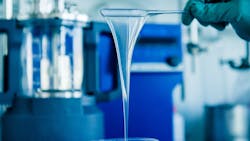A new process for synthesizing polysiloxanes — also known as silicones — prevents the formation of small, toxic, endocrine-disrupting impurities known as cyclic oligosolixanes that have long dogged manufacturers.
Mass production of silicones proceeds with the steady growth of silicon-oxygen chains. However, a small fraction of these chains “bite back” on themselves late in the reaction, generating 6-, 8-, 10-, 12- and 14-membered cyclic oligosolixanes. The result is an 85%/15% thermodynamically controlled ratio of polymer-to-impurity per batch.
With silicones finding ever more industrial and healthcare applications — nearly 50% of new skincare products contain at least one type, for example — finding ways to prevent the byproduct is crucial.
The new process, developed by a team of scientists drawn from the Centre National de la Recherche Scientifique (CNRS), Paris; the chemical department of the Autonomous University of Barcelona; and the specialist chemical company Elkem Silicones, Saint-Fons, France, focused on the 8-membered ring which is the most thermodynamically favored of the oligosolixane impurities.
They took a twin approach to tackling the problem. First, at the end of the developing silicone chain, benzyl alcohol is applied to inhibit the back-biting process. Secondly, the alcohol helps stabilize a phosphonium cation. In the absence of benzyl alcohol, this decomposes and deactivates chain growth, acting as a self-quenching system that likewise prevents byproduct formation.
According to CNRS researcher Tsuyoshi Kato, the success of this approach could have a considerable impact on the manufacture of silicones.
“On the basis of the knowledge acquired, we are developing other catalyst models that are more efficient and more persistent under ambient conditions, making them more suitable for industrial applications,” he says.
In terms of scaling up the process, Kato notes the highly air-sensitive nature of the catalysts (initiators) used is one of the most significant limiting factors for this system.
“We are currently working on improving this point by modifying the catalyst structure and developing an air-stable catalyst,” he adds.
Nevertheless, Kato points out that the overall catalyst system is being developed in collaboration with Elkem Silicones to industrialize it.
A paper describing the work in a recent issue of Science notes that the findings already have been patented by Elkem Silicones.
About the Author
Seán Ottewell
Editor-at-Large
Seán Crevan Ottewell is Chemical Processing's Editor-at-Large. Seán earned his bachelor's of science degree in biochemistry at the University of Warwick and his master's in radiation biochemistry at the University of London. He served as Science Officer with the UK Department of Environment’s Chernobyl Monitoring Unit’s Food Science Radiation Unit, London. His editorial background includes assistant editor, news editor and then editor of The Chemical Engineer, the Institution of Chemical Engineers’ twice monthly technical journal. Prior to joining Chemical Processing in 2012 he was editor of European Chemical Engineer, European Process Engineer, International Power Engineer, and European Laboratory Scientist, with Setform Limited, London.
He is based in East Mayo, Republic of Ireland, where he and his wife Suzi (a maths, biology and chemistry teacher) host guests from all over the world at their holiday cottage in East Mayo.

